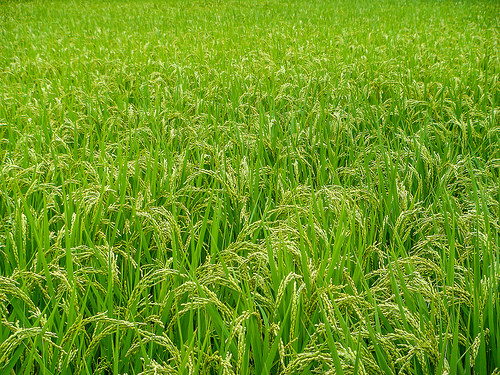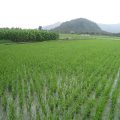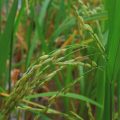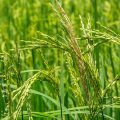Farmers in big rice provinces Nueva Ecija and Pangasinan will enjoy a P300 per five-kilo (P1,200 for 20 kilos) hybrid rice seed aid this rainy season which should enable them to help boost Philippines’ 2013 rice production.

Philippines’ pioneer hybrid rice seed producer SL Agritech Corp. (SLAC) is extending the aid in the form of a discount to selected rice-producing provinces.
These areas have been identified for the potential to yield substantially more than what these are harvesting in the rainy season (September, October for Luzon) using ordinary seeds. Ilocos provinces, Bulacan, and Tarlac are also included in the SLAC discount program.
The potential increase in yield using hybrid rice is at least one metric ton (MT) or 20 cavans per hectare compared to ordinary seeds.
“They say hybrid rice is not good for the wet season. But farmers that continue to use SL-8 during the wet season harvest higher than inbred, although of course you don’t expect to yield 200 to 250 cavans. But they will yield 120 to 150, so that’s still better than 60 to 80 cavans,” said SLAC Chairman Henry Lim Bon Liong.
Farmers have been veering away from the use of hybrid rice seeds in the wet season owing to heavy infestation of bacterial leaf blight (BLB).
However, SLAC is recommending a specific protocol for the wet season.
This includes better land preparation and removal of weeds to prevent pestilence; transplanting of the seedlings 18 to 21 days from seeding; water draining through clean drainage pipes as flooding prevents simultaneous growth of plants; reduction in nitrogen fertilizer by using only 80 to 115 kilos per hectare as nitrogen causes leaf overgrowth and weak plants; and proper use of bactericide-fungicide.
Pangasinan and Ilocos provinces are both ideal sites for hybrid rice rainy season planting since land remains dry or well-drained despite the rains, according to Dr. Frisco M. Malabanan, SLAC hybrid rice specialist.
“Wet season planting is good in Pangasinan which is a rainfed lowland area. Rice plants are not always soaked in water. Ilocos is relatively dry even in the wet season,” said Malabanan.
SLAC has been proactive in developing the technology to help farmers keep a high yield in the wet season.
It is optimistic about obtaining a certification with the National Seed Industry Council for its new BLB-resistant variety, SL-18. It has been receiving outstanding feedback with yield of as much as 235 cavans (11.75 MT) per hectare in Bohol in the wet season of 2012. SL-8H is already BLB-tolerant, but SL-18 has been developed to have stronger control against BLB and is considered a BLB-resistant variety.
This variety has been going through National Cooperative Testing (NCT). Having finished two croppings of field test—the wet season of 2012 and the current dry harvest–it expects to receive certification from the NSIC in another year.
“The NCT is not finished yet, but that doesn’t stop a company from putting it in the market since the company is confident about its performance. It’s just more concerned about putting internal quality control,” said Malabanan.
Several technology demonstration areas in Cagayan Valley, Davao del Sur, and Norala in South Cotabato have shown good performance of SL-18 in the wet season.
With generally dry areas like Pangasinan and Ilocos, the Philippines can actually raise its rice hybridization area nearer to 100 percent.
This can make the country a rice exporter even of regular rice. There are government prohibitions to export regular rice now. SLAC is exporting only fancy rice (Jasponica, Miponica) under a agriculture/” title=”View all articles about Department of Agriculture here”>Department of Agriculture (DA) program this year.
“In China, their hybrid rice area is just almost 60 percent because they have highlands affected by winter. But (Father of Hybrid Rice) Prof. Yuan Longping said we can attain 100 percent rice planting
because our weather is good (dry tropical weather). We can plant hybrid rice year-round,” Lim said.
The country’s hybrid rice area is only at five percent at 146,000 hectares in 2012.
With hybrid rice, farmers can actually fulfill DA Secretary Proceso J. Alcala’s 10-5 dream (10 tons per hectare yield at P5 per kilo cost).
Asian countries are compelled to use hybrid rice in order to meet demand for increasing food. One hectare of land should be able to feed 43 people in 2030 from present feeding rate of 27, according to Yuan.
One farmer in Nueva Ecija harvested 12.5 MT per hectare at a cost of only P47,000. This translates to a per kilo cost of only P3.76.
These are actual documentation of farmers’ yield and cost in Nueva Ecija: Ricardo Buenaventura, 209 cavans (10.45 MT) for 11,000 square meters (sq.m.) at P3.20 per kilo; Rene Valdez, 200 cavans (10 MT) in 12,000 sq.m. at P3.08 per kilo; and Maria Martin, 322 cavans (16.2 MT) over 14,000 sq.m. at P2.35 per kilo.
Policies should also be improved to promote food security and export.
Lim said the National Food Authority should come up with a bigger palay (unmilled rice) buying program to support the country’s potential export similar to how Thailand pours investments for its rice farmers.
“The Thai government is pumping $8 billion to purchase rice, so all their farmers are very happy. Maybe their government loses $2 billion for selling it at a low price, but they get more in multiplier effect from the $8 bilion that went to farmers,” he said.
DA-Land Bank’s loan facility should also be increased.
“The P500 million (DA) loan program is small. I hope its budget is P3 to P5 billion, so we can really be sufficient. If you still remember, in the last administration, we were importing P65 billion worth of rice. But even if you give just a P5 billion subsidy for rice, the money still goes around within the country rather than given away to rice farms abroad,” he said.
Smuggling should be prevented as the non-taxed imports compete heavily with local production.
“Smuggled rice is very profitable. It only costs $350 to $400 per ton which is just equivalent to P15 per kilo while our milled rice can cost P20 to P30 per kilo. If the smuggled rice will pay tax, we can compete with them, but smugglers don’t pay tax,” said Lim.
###
About Bacterial Leaf Blight (BLB) Tolerance and Resistance
Tolerance to disease means that infection of rice plants from BLB can be reduced using this tolerant variety. But resistance means a higher level of control against BLB, actually inhibiting infection.
“Tolerance strategies do not limit infection, but reduce or offset its fitness consequences,” as defined by a Geobotanical Institute of Switzerland study. “Resistance defenses inhibit or limit infection.”
BLB, appearing as brown spots in rice plant’s leaves, can wipe out an entire harvest (100 percent loss) particularly pronounced in the rainy season. SL-8H is considered a BLB-tolerant variety, but SL-18 has been developed as a BLB-resistant variety.
About Hybrid Rice
Hybrid rice is a product of the breeding, or cross pollination, of two genetically different parents that have superior traits– for instance, one high-yielding and another one with grains that are aromatic (a palatable smell and taste). It is generally superior over inbred varieties that are a result of the mating of two very related parents that cannot offer much trait advantage. Inbreeding also comes naturally in the form of self-pollination that occurs in many plants– orchids, peas, and legumes like peanut. In these plants, male and female reproductive organs are within the same plant, enabling pollination within itself.
Hybrid rice production does not involve genetic modification as in genetically modified organisms, but it is considered a natural way of breeding through selection of plant materials that have the desired trait.
Other Leads in this Press Release:
1. A new bacterial leaf blight (BLB)-resistant variety is being released to the market by Philippines’ pioneer hybrid rice producer SL Agritech Corp. that can enable farmers to reap an additional one metric ton from their rainy season harvest.
2. The Philippines has the potential to expand hybrid rice on nearly 100 percent of rice area due to its dry tropical climate, but the National Food Authority should budget a bigger palay buying support similar to Thailand’s $8 billion rice support program.
3. The government should fight hard against smuggling as non-taxed smuggled rice lands at only $350-$400 per ton or just P15 per kilo which renders the local produce uncompetitive with its P25 to P30 per kilo cost (rice form).
For any questions, please call Ms. Joh Dungca, 0917-558-6508; for interview requests, 0923-436-3177






Hi, I’m planning to plant hybrid rice on the next planting season. May I know what is the recommended hybrid rice seed that can be planted during wet season/ My place is located in Alicia, Isabela. Thanks, Art
please answer all querries here. How much is SL-18 seeds for one hectare?
where do we find a sample of cash flow diagram?
PSE Academy (www.pseacademy.com.ph) provides a comprehensive, interactive, and practical web-based investor education for market participants, would-be equity investors, and the public in general.